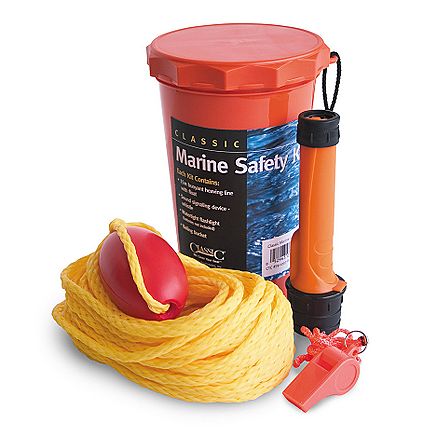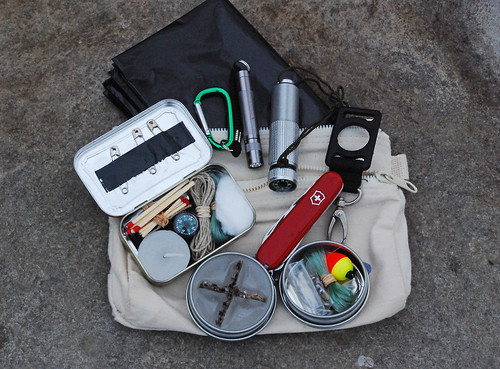Most literature out there suggests that it's good to have at least 72 hours of preparations ready to survive in case of a sudden disaster (natural - like the recent Sandy storm, biological - like the flu, etc)
So what does this mean? Well first off you have to consider where you live and the season you will prepare for. It's fine to have your survival kit set up for summer, but if an ice storm knocks out your power for 3 days, that swimsuit won't really help you. Also you have to think about where you expect to be, will you be out in the woods where having a fire starting kit will come in handy, or are you in an apartment building where a small propane stove might serve you better?
So what is a survival kit? Well they go by different names depending on it's purpose (there are more then I describe here):
Survival/Emergency Kit - usually a commercially available kit that has the basics for when you experience a natural disaster. It has food, water, flashlight, radio and a first aid kit. It is designed for when you want or need to stay where you are. This is what you use while you are waiting for services to come back.
Bug out Bag - usually a kit that people design for themselves. Often times all the supplies are contained within an easy to carry bag. (one friend of mine had a vest - it was an army flak vest that he had clipped all the various supplies to.) The purpose of a bug out bag (BOB) is when you plan to leave the situation you are in. With that in mind, most contents are tailored for travel; light weight, small, and often includes shelter. Items contained in a BOB can include: food (usually dehydrated), water purification system, flashlight, radio, tarp (for shelter), rope, first aid kit, clothing and some tools.
Emergency Road Kit - This is a kit that you have in your car. This is if you car breaks down on the side of the road you have the tools/items to fix the problem or the things you need to survive until help arrives. They usually include: jumper cables, bungee cords, tools (screwdriver, pliers, wrenches), flashlight, first aid kit, poncho, duct tape, pylons and car care guide.
Marine Safety Kit - This is for when you are on a watercraft. In Canada you legally need to have one of these, even in small craft like a kayak. These kits include: a floating rope (heaving line), waterproof flashlight, waterproof whistle, and a bailing bucket.
First Aid Kit - This is a kit that is used when there is a medical emergency (minor or otherwise). These are often commercially available and they contain a number of different items based on the purpose of the kit. Basic kits include: bandages, gauze, antiseptic wipes, gloves, burn cream, tweezers, and other minor wound care. Some kits are activity specific, so there are wilderness first aid kits (often have more burn cream, blister treatment, elastic bandage for twisted ankles), or first responder ones (often have pocket masks, face shield, sutures, blood pressure cuff) Items that are not always included in kits, but you should include in yours is medication. Pain killers, stomach meds, cold meds, and most importantly any prescription medication.
Wilderness Survival Kit - This kit is designed for when you are out in the wilderness and usually contains items that would be useful in that situation like: matches, snare wire, tarp, small knife, whistle, compass, rope, first aid kit, flashlight.
This list is not all inclusive, and sometimes these kits overlap.
Some items that people often overlook when making BOB and emergency kits:
- Important documents/identification (passports, drivers licence, SIN card, credit card numbers, wills, insurance policies, etc. Photocopies of these are a good idea)
- Money (you might not be able to use your debit card, so make sure to have some cash and valuables that you can trade)
- Personal effects (it might not seem important, but if your house is burnt down you may want to have a photo of your family, or your grandmothers ring)
- A USB of important info/photos/items (most of us have our photos on our computers, but you might not have the time to grab it on your way out the door. Also it's a lot easier to carry a USB of the contents than to lug your laptop around)
- List of contact info (yes you have your mom's number in your cell phone, but it might die and then you can't contact your loved ones. Also it's good to have addresses as well)
- Map (it's good to have a city map, and/or a provincial/state map as googlemaps might not work)
- Entertainment (if you loose power, having a pack of playing cards will come in handy, or some of those travel board games will entertain both you and your children)
- Pencil and paper (pens will run out and don't always write. You might need to draw maps, write notes, keep lists)
- Luxury item (While having all the survival basics, sometimes it's nice to have a luxury item. This could be some chocolate, a toy for your child, or some instant coffee, when the shit hits the fan (SHTF) it's sometimes really a moral booster if you can have just one small luxury)
- Keys (spare key to your house, car, safety deposit box)
- Toilet paper (trust me, you will want this. You could even have a couple cloths that you wash and dry in the sun to sanitize, but you will want something to take care of things down below ;p)
So how to make your own BOB, first aid kit, survival kit? There are plenty tools out there to help you; checklists, commercially available kits, and books. I will post more info on this blog but here are some links to help you get started:
Get Prepared
This site is set up by the Canadian government. It has a number a good guides on how to prepare (mostly for natural disasters) It talk about setting up an emergency plan with your family. It's all great if you know what your doing, but if you kids or spouse doesn't know the meeting place if there is a fire then everyone could be hurt or experience unneeded stress. They even have a section about pets, who are often overlooked in an emergency situation.
Personal Emergency Kit Checklist
This site is again brought to you by the Canadian government. It is a quick and dirty checklist.
Bug Out Bag Template
This site is full of zombie apocolype info, but within it, there are a lot of great resources. This BOB checklist is really great as you can copy it and fill it in with what items you have and you can easily see what items you still need.
A challenge you can do see if you (and your family) is ready:
"Emergency/BOB kit preparedness Challenge"
Contact a friend or family member and explain that you are doing some emergency prep (don't say you are getting ready for the zombie apocalypse - only if your loved ones will understand and not think you're crazy). Then tell them to call your house sometime within the next week. Ask them to tell you
"Your house is on fire" or
"There is an ice storm and you just lost power" or
"There's a flu pandemic happening"
AND
"You have _____(insert time here) to get yourself/family ready."
Then they hang up and you have however much time to get you and your family ready.
Example:
"There has been a major storm and you have just lost power to your house. Services will not be available for 72 hours. You have 20 minutes to get your family ready to endure this emergency."
Then set a timer for 20 minutes and see how ready you actually are if this scenerio actually happened. (Do you have enough water if the water pumps stopped working? Do you have enough candles/flashlights for 72 hours? Do you have enough food, and the means to cook it? What about clean underwear - and diapers if your child needs them?)
Be prepared and survive!
~Kate








No comments:
Post a Comment